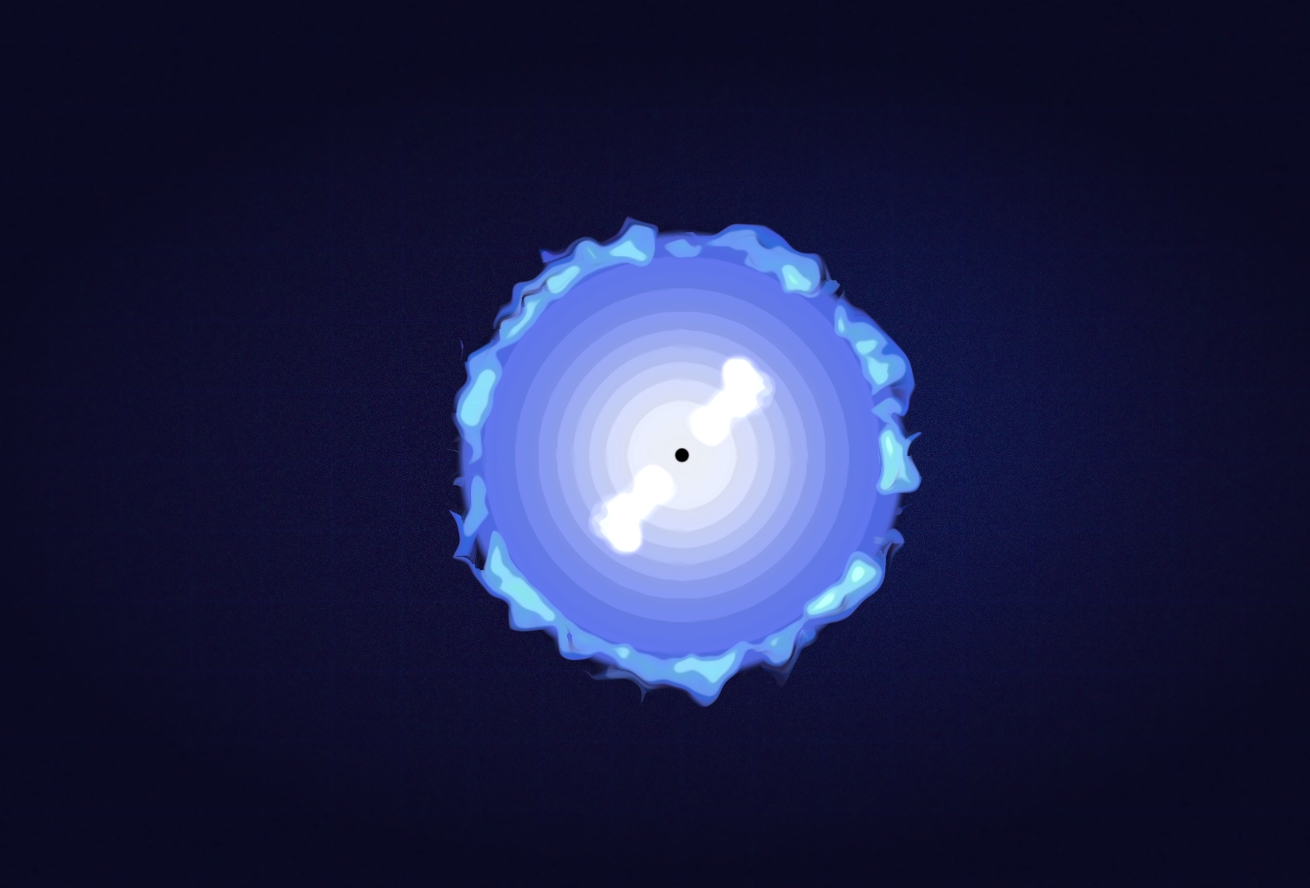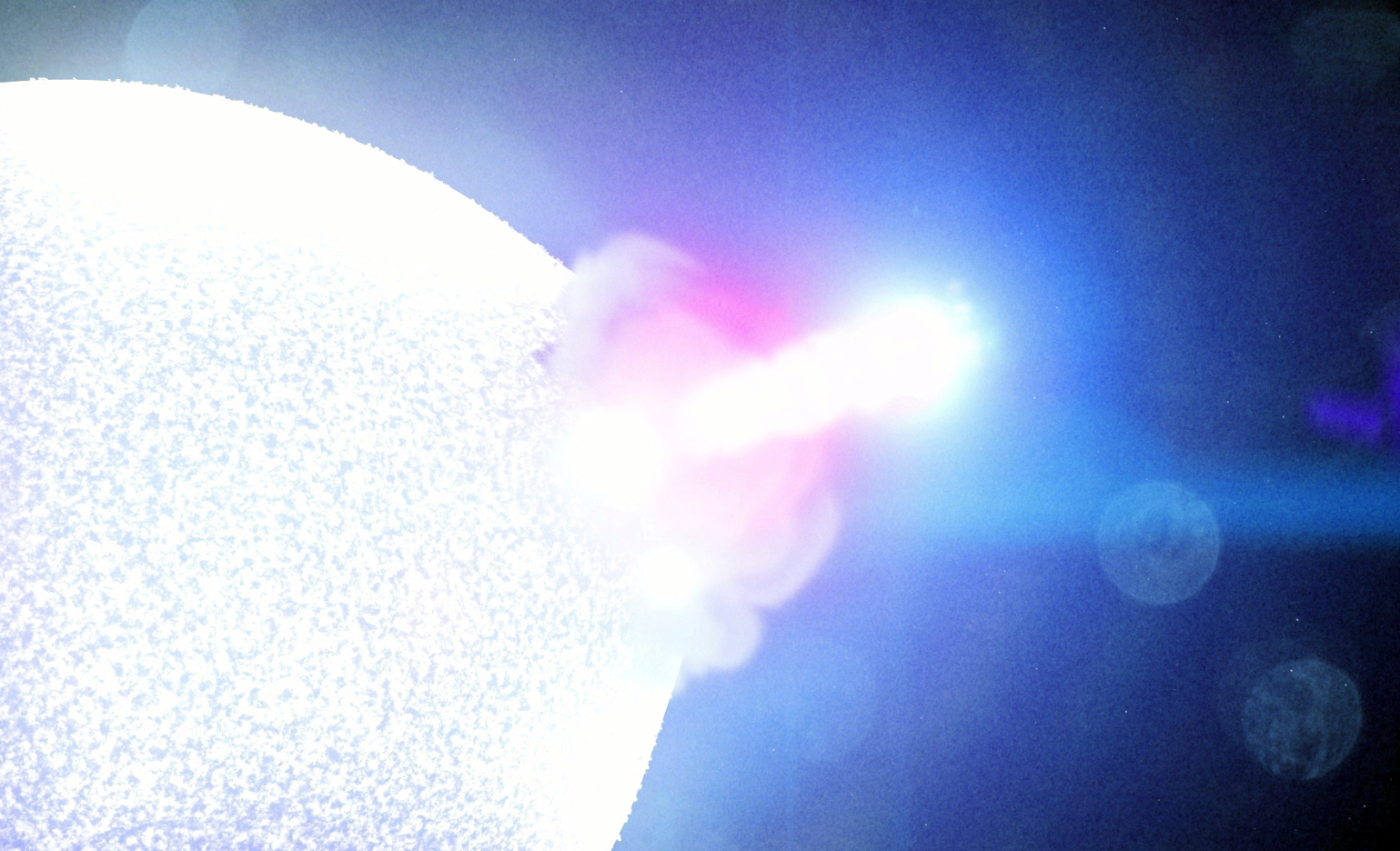The massive star that barely shone upon death
The IAA-CSIC participates in two articles that disseminate the discovery of the shortest gamma ray burst (GRB) produced by the death of a massive star ever detected
On 26 August 2020, NASA's Fermi space telescope detected a pulse of high-energy radiation that, with a duration of only one second, broke a record: it was the shortest gamma-ray burst (GRB) caused by the death of a massive star ever seen. Its study, in which the Institute of Astrophysics of Andalusia (IAA-CSIC) participates, shows that the classification of these bursts according to their duration does not entirely correspond to reality and opens up new scenarios in the death of stars.
GRBs are the most energetic phenomena in the universe, detectable even if they occur in galaxies billions of light years away. They are classified as short or long depending on whether the event lasts longer than two seconds, and their duration is associated with their origin: long bursts occur with the death of massive stars, while short bursts have been linked to the merger of two compact objects, such as neutron stars.
"We already knew that some GRBs produced by massive stars could be recorded as short GRBs, but we thought that this was due to instrumental limitations", says Bin-bin Zhang, from Nanjing University (China) and the University of Nevada, Las Vegas. This outburst is special because it is a short GRB, but its properties point to a collapsing star as the origin: we now know that dying stars can also produce short outbursts”.
Named GRB 200826A after the date it occurred, this outburst is the subject of two papers published today in Nature Astronomy. The first, led by Zhang, explores the gamma-ray data. The second, led by Tomás Ahumada of the University of Maryland and NASA's Goddard Space Flight Center, describes the fading of the GRB's multiwavelength glow and the emerging light from the supernova explosion that followed.
“We think this event was effectively a fizzle, one that was close to not happening at all,” Ahumada said. “Even so, the burst emitted 14 million times the energy released by the entire Milky Way galaxy over the same amount of time, making it one of the most energetic short-duration GRBs ever seen.”
MASSIVE STARS ALSO PRODUCE SHORT GRBs WHEN DYING
When a very massive star exhausts its hydrogen fuel, its core collapses and a black hole forms. As matter swirls around the black hole, some of it escapes through two powerful jets that rush outward at almost the speed of light in opposite directions. Each jet pierces the star, producing a gamma-ray signal that can last for up to several minutes, while the jet moves away and interacts with the surrounding gas. After the outburst, the star's envelope rapidly expands into a supernova. A GRB is only detected when one of these jets happens to point almost directly toward Earth.

The groups behind the two papers propose different scenarios to explain this strange outburst. For example, GRB 200826A could have been driven by jets that barely left the star before going out, rather than the more typical case where jets emerge from the star and travel long distances to produce a long-lived outburst.
“This outburst could even belong to a class of short GRBs involving new scenarios, such as the merger of a normal star and a neutron star, or magnetic bubbles induced by differential rotation (different rotation speeds of the equator and the poles of a star) as a mechanism for producing gamma-ray emissions –says Alberto Castro-Tirado, a researcher at the IAA-CSIC who participates in the two publications–. More generally, this result clearly shows that the duration of an outburst does not indicate its origin”.
The discovery helps resolve a long-standing puzzle. While long GRBs must be coupled to supernovae, astronomers detect far greater numbers of supernovae than they do long GRBs. This discrepancy persists even after accounting for the fact that GRB jets must tip nearly into our line of sight for astronomers to detect them at all.

MULTIPLE OBSERVATIONS FROM SPACE AND FROM THE GROUND
The GRB 200826A constituted a strong high-energy explosion that was detected by the Fermi space telescope, as well as the Wind mission (NASA), Mars Odyssey (NASA) and the INTEGRAL satellite of the European Space Agency (ESA), participating in a GRBs location system called Interplanetary Network (IPN). Since the burst reaches each detector at different times, any pair of them can be used to narrow down where in the sky it occurred. About seventeen hours after the GRB, the IPN narrowed it down to a relatively small area of the sky in the Andromeda constellation.
Using the Palomar Observatory's Zwicky Transient Facility (ZTF), the team scanned the sky for changes in visible light that could be related to the GRB's afterglow fading. Of the more than 28,000 ZTF alerts from the first night, only one met all the search criteria. One day after the blast, X-ray emission was found in the same region and two days later in radio waves. Thanks to measurements with the Gran Telescopio Canarias (La Palma), the team showed that the light from the GRB had taken 6.6 billion years to reach us (this represents 48% of the current age of the universe, which is 13.8 billion years).
But to show that this brief burst came from a collapsing star, it was necessary to also capture the glow of the emerging supernova. Observations with the Gemini North telescope made it possible to detect, starting 28 days after the explosion, a source in the near infrared: the supernova.
Ahumada, T. et al, “Discovery and confirmation of the shortest gamma ray burst from a collapsar”, Nature Astronomy, , https://www.nature.com/articles/s41550-021-01428-7
Zhang, B.-B. et al, “Peculiarly Short-duration Gamma-Ray Burst from Massive Star Core Collapse” , Nature Astronomy, https://www.nature.com/articles/s41550-021-01395-z
Instituto de Astrofísica de Andalucía (IAA-CSIC)
Unidad de Divulgación y Comunicación
Silbia López de Lacalle - sll[arroba]iaa.es - 958230676
https://www.iaa.csic.es
https://divulgacion.iaa.csic.es

